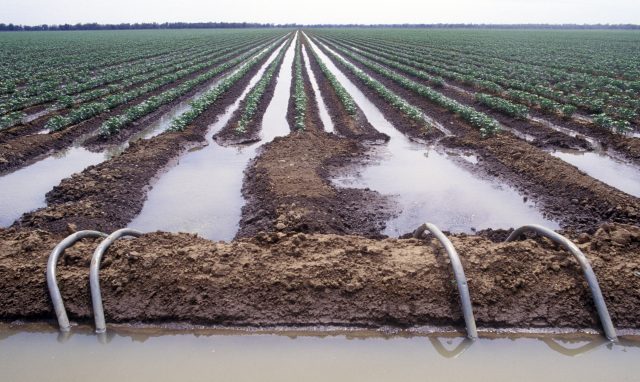Water is a precious commodity that gives life to plants – just like the way that information and knowledge helps people learn and adapt during times of organizational change. The methods used to share and disseminate information and knowledge throughout the organization play a vital role in the success of the change initiative. If not planned and delivered, the vital information – like water needed by thirsty plants – gets washed away and wasted. In this post, I share three ways that wise leaders can better move their key messages of change throughout the organization and reach the end of each row.
Method 1: Water sprinklers.
Sprinklers move water that is pressurized through pipes, and out through sprinkler heads. The water droplets are sprayed with a fine mist across a large distance into the air and down to the ground. Thus, everything on the ground, including weeds, receive water.

From an OCM perspective, this method of watering represents messages sent from senior leaders out to a broad audience. These messages can be via email or town hall and all-hands meetings. People hear high-level information that applies to the organization at a general level and they see their leaders’ vocal and visible commitment to the change.
Method 2: Surface or flood irrigation.
Farmers often water crops by flood or surface irrigation. Rows are flooded with water siphoned from a canal and distributed over the soil surface by gravity. Flood irrigation is one of the most common forms of irrigation throughout the world. It has remained virtually unchanged for thousands of years. (1) While this method requires very little equipment or technology, farmers need an abundant source of water.
From an OCM perspective, surface or flood irrigation represents the need to saturate people with information. Each day, we are all bombarded with many messages and distractions in the workplace. Getting people to hear, recognize, and remember your message can be a challenge.
The famous Rule of 7 reminds us that people need to see or hear your message seven times before they take action. Wise change leaders will plan and orchestrate a coordinated communication campaign that includes immersive messages. This includes posters, digital signage, corporate intranets, project dashboards and timelines, tent cards, desk drops, and postcards. Live one-on-one and group discussions about the change and how the change makes us feel and will benefit us is where the rubber meets the road.
Method 3: Dripline.
Drip irrigation consists of a network of tubes and values throughout the field of crops. This method of irrigation is more efficient because of reduced waste. The root of the plant receives water directly, and reduced water evaporation.

From an OCM perspective, drip irrigation represents key messages that leaders share with their direct reports through one-on-one coaching discussions. These formal and informal communications are where the rubber meets the road. Conversations between leaders and employees are more effective than other methods. Open and tailored discusses the impacts, concerns, and benefits employees experience.
Conclusion
This blog outlined three methods to bring water to grow crops as an analogy of different methods leaders can use to share information and help their people thrive and adapt during times of change. Each method has advantages depending on the different climates, resources, and ground conditions. Just like the different functions and geographic regions of your organization.
Regardless of the methods used, farmers and leaders face a common challenge. Ensure the water moves from the source down through the channels to reach the end of the row. What strategies and tactics do you find to be most effective for communicating change?
Read more about organizational change management here.


Great analogy. No matter how it’s done, that water needs to get distributed evenly and consistently. Thanks for the interesting read, Mike!